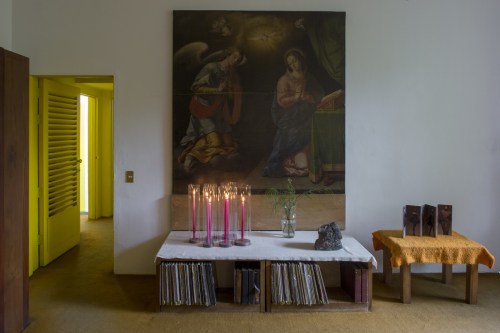
From November 5, 2018 to Januray 13, 2018, Estancia FEMSA and Casa Luis Barragan present an individual exhibition by the renowned Danish artist Danh Vo (Bà, Rja, Vietnam, 1975). The pieces and interventions in the exhibition, created specifically for this space, use a series of silent and discreet gestures to explore the life and architecture of the objects and people that have inhabited Casa Luis Barragan.
In the first of the exhibition, Danh Vo reveals the invisible systems that work behind the scenes to ensure the smooth running of the house, as well as the conservation efforts made by its staff. The artist proposes subtle changes in his maintenance routines, such as removing carpets to expose the traces left by light over the years; quickly restoring space and furniture resources; and refurbishing areas closed to the public. It also moves objects or exacerbates decorative elements, such as flower arrangements made by employees. Thus, the artist showa the temporal layers that have accumulated in space, as well as the multiple transformations it has undergone since its construction, thus pointing out the impermanence of his museographic discourse and understanding Barragan's architectur as a living archive and an active laboratory of ideas.
The second part of the project is an installation in which Danh Vo has arranged numerous beeswax candles, made by master craftsmen from Oaxaca, throughout the house. To produce the candles, the artisans put the wax in the sun for days to whiten its natural yellow color; assemble the candles layer by layer; and finally dye them with different densities of carmine. The interaction between materials and the environment, and their trnasformation over time, is a constant source of fascination in Danh´s Vo work.
The candles allude to the historical lineage of the carmine dye extracted from the cochineal insect: a pre-Hispanic technique of cultural application that survived the Viceroyalty and became an essential part of the new Spanish economy. The ceremonial nature of these candles also evokes the Catholic faith, which is a central theme both in Barragan's life and work and in Danh's own explorations (although in very different way). Using these specific elements of Mexican cultural history, the artist reflects on the colonization, globalization and resignification that occurs when objects are removed from one context and then "migrate" to another.
This installation will create new experiences for visitors to Casa Luis Barraga. As the lit candles burn during the exhibition, guests will encounder a sunset inside the space: a new internal dialogue between light and shadow.
Vo's project, Garden with Pigeons in Flight, points out the necessary instability of the historical narrative through almost imperceptible displacements and soft new touches.
Trad. Robin Myers; Rev. Javier Ledesma